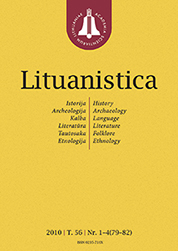LituanisticaWHAT?
 ISSN 0235-716X |
2005 m. Nr. 4 Parodomųjų įvardžių įsisavinimas
In this article, we are concerned with the acquisition of Lithuanian demonstrative pronouns; special attention is paid to their morphological form and meaning, the emergence of their grammatical categories, such as case, gender and number.
The analysis is based on a longitudinal data of one Lithuanian girl. Her speech was recorded in natural situations. Recordings were started in 2000, the girl was recorded twice or three times a week for about 15–20 minutes. The total number of recordings is 42 hours. The electronic data are supplemented with diary recordings documented from the age of 1;0. According to the hypothesis that children start using those demonstrative pronouns referring to objects closer to the speaker, our data confirm that the pronoun šitas ‘this’ emerges earlier in the speech of a child, and the pronoun anas ‘that’ emerges later. The pronoun šitas ‘this’ is used most frequently, the pronoun tas ‘that’ occurs rarely and the pronoun anas ‘that’ is the rarest. Demonstrative pronouns as substitutes of nouns perform typical semantic and syntactic functions of noun cases. The nominative is the most frequent case, and it functions as a subject. The accusative and the genitive function as an object, and the genitive in a prepositional phrase (with ant ‘on’) is an adverbial of place. The dative and the instrumental function as a benefactive and an instrument. When the pronouns substitute the adjectives they perform a typical attributive syntactic function. |
Numeriai:
2011 - T.57 Nr.1, Nr.2, Nr.3, Nr.4 2010 - T.56 Nr.1-4 2009 - T.55 Nr.1-2, Nr.3-4 2008 - T.54 Nr.1, Nr.2, Nr.3, Nr.4 2007 - T.53 Nr.1, Nr.2, Nr.3, Nr.4 2006 Nr.1, Nr.2, Nr.3, Nr.4 2005 Nr.1, Nr.2, Nr.3, Nr.4 2004 Nr.1, Nr.2, Nr.3, Nr.4 2003 Nr.1, Nr.2, Nr.3, Nr.4 2002 Nr.1, Nr.2, Nr.3, Nr.4 2001 Nr.1, Nr.2, Nr.3, Nr.4 |